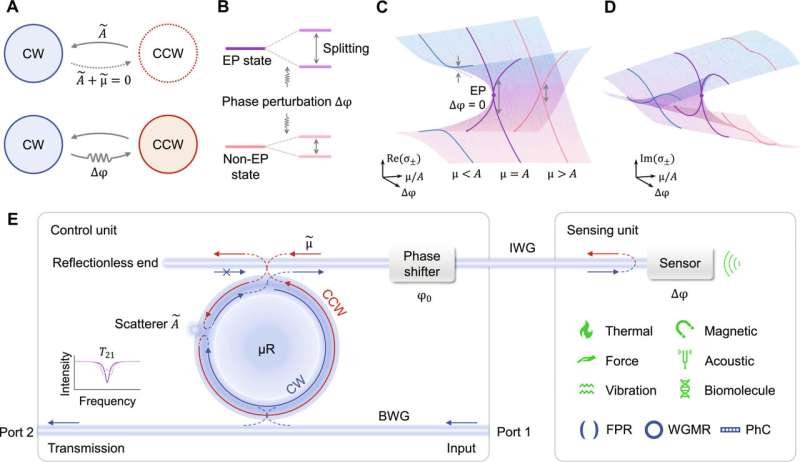This article has been reviewed according to Science X's editorial process and policies. Editors have highlighted the following attributes while ensuring the content's credibility:
fact-checked
peer-reviewed publication
trusted source
proofread
Innovative sensing platform unlocks ultrahigh sensitivity in conventional sensors

Optical sensors serve as the backbone of numerous scientific and technological endeavors, from detecting gravitational waves to imaging biological tissues for medical diagnostics. These sensors use light to detect changes in the properties of the environment they're monitoring, including chemical biomarkers and physical properties like temperature. A persistent challenge in optical sensing has been enhancing sensitivity to detect faint signals amid noise.
New research from Lan Yang, the Edwin H. & Florence G. Skinner Professor in the Preston M. Green Department of Electrical & Systems Engineering in the McKelvey School of Engineering at Washington University in St. Louis, unlocks the power of exceptional points (EPs) for advanced optical sensing. In a study published April 5 in Science Advances, Yang and first author Wenbo Mao, a doctoral student in Yang's lab, showed that these unique EPs—specific conditions in systems where extraordinary optical phenomena can occur—can be deployed on conventional sensors to achieve a striking sensitivity to environmental perturbations.
Yang and Mao developed an EP-enhanced sensing platform that overcomes the limitations of previous approaches. Unlike traditional methods that require modifications to the sensor itself, their innovative system features an EP control unit that can plug into physically separated external sensors. This configuration allows EPs to be tuned solely through adjustments to the control unit, allowing for ultrahigh sensitivity without the need for complex modifications to the sensor.
"We've implemented a novel platform that can impart EP enhancement to conventional optical sensors," Yang said. "This system represents a revolutionary extension of EP-enhanced sensing, significantly expanding its applicability and universality. Any phase-sensitive sensor can acquire improved sensitivity and reduced detection limit by connecting to this configuration. Simply by tuning the control unit, this EP configuration can adapt to various sensing scenarios, such as environmental detection, health monitoring and biomedical imaging."
By decoupling the sensing and control functions, Yang and Mao have effectively skirted the stringent physical requirements for operating sensors at EPs that have so far hindered their widespread adoption. This clears the way for EP enhancement to be applied to a wide range of conventional sensors—including ring resonators, thermal and magnetic sensors, and sensors that pick up vibrations or detect perturbations in biomarkers—vastly improving the detection limit of sensors scientists are already using. With the control unit set to an EP, the sensor can operate differently—not at an EP—and still reap the benefits of EP enhancement.
As a proof-of-concept, Yang's team tested a system's detection limit, or ability to detect weak perturbations over system noise. They demonstrated a six-fold reduction in the detection limit of a sensor using their EP-enhanced configuration compared to the conventional sensor.
"With this work, we've shown that we can significantly enhance our ability to detect perturbations that have weak signals," Mao said. "We're now focused on bringing that theory to broad applications. I'm specifically focused on medical applications, especially working to enhance magnetic sensing, which could be used to improve MRI technology. Currently, MRIs require a whole room with careful temperature control. Our EP platform could be used to enhance magnetic sensing to enable portable, bedside MRI."
More information: Wenbo Mao et al, Exceptional–point–enhanced phase sensing, Science Advances (2024). DOI: 10.1126/sciadv.adl5037
Journal information: Science Advances
Provided by Washington University in St. Louis




















